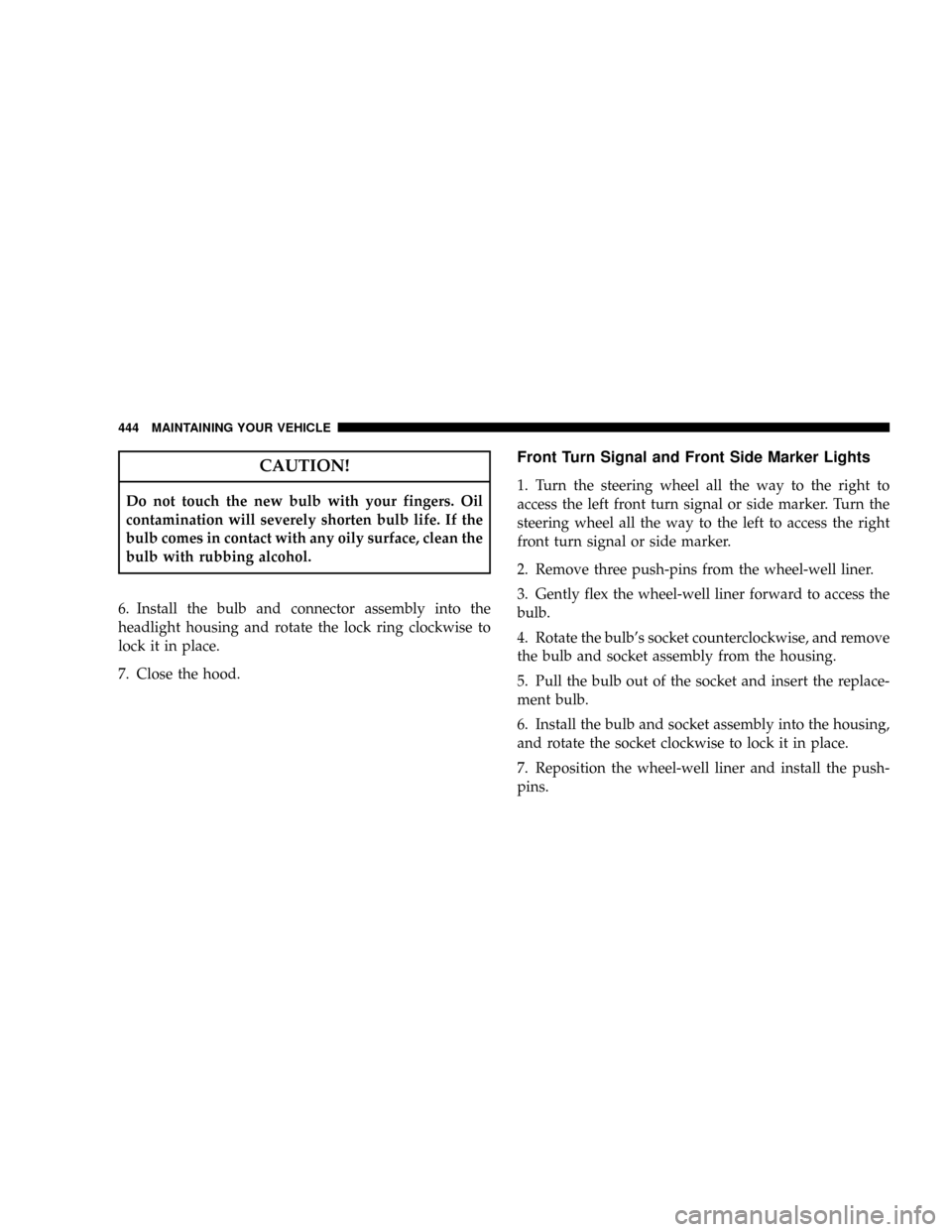Page 396 of 493

NA/C Air Filter Ð If Equipped............412
NPower Steering Ð Fluid Check............412
NDriveline And Steering Component
Lubrication..........................413
NBody Lubrication.....................413
NWindshield Wiper Blades................413
NWindshield & Rear Window Washers.......414
NExhaust System......................415
NCooling System.......................416
NHoses And Vacuum/Vapor Harnesses.......421
NFuel System.........................421
NBrake System........................422
NClutch Hydraulic System Ð Manual
Transmission (If Equipped)..............424NAutomatic Transmission................425
NManual Transmission Ð If Equipped.......426
NTransfer Case........................426
NFront/Rear Axle Fluid..................428
NAppearance Care And Protection From
Corrosion...........................428
mSky SlidertTopCare ....................434
NWashing............................434
NGeneral Cleaning.....................434
NAdditional Cleaning Procedure............435
NProtection...........................435
NWeather Strip Care....................436
mFuses (Integrated Power Module)...........436
396 MAINTAINING YOUR VEHICLE
Page 412 of 493

Refrigerant Recovery and Recycling
R-134a Air Conditioning Refrigerant is a hydrofluorocar-
bon (HFC) that is endorsed by the Environmental Pro-
tection Agency and is an ozone-saving product. How-
ever, the manufacturer recommends that air conditioning
service be performed by dealers or other service facilities
using recovery and recycling equipment.
NOTE:Use only manufacturer approved A/C System
Sealers, Stop Leak Products, Seal Conditioners, Compres-
sor Oil, and Refrigerants.
A/C Air Filter Ð If Equipped
Refer to the ªMaintenance Scheduleº in Section 8 of this
manual for A/C Air Filter service intervals.
WARNING!
Do not remove the A/C Air Filter while the blower is
operating or personal injury may result.
Power Steering Ð Fluid Check
Checking the power steering fluid level at a defined
service interval is not required. The fluid should only be
checked if a leak is suspected, abnormal noises are
apparent, and/or the system is not functioning as antici-
pated. Coordinate inspection efforts through a certified
DaimlerChrysler Dealership.
WARNING!
Fluid level should be checked on a level surface and
with the engine off to prevent injury from moving
parts and to insure accurate fluid level reading. Do
not overfill. Use only manufacturer's recommended
power steering fluid.
412 MAINTAINING YOUR VEHICLE
Page 413 of 493

If necessary, add fluid to restore to the proper indicated
level. With a clean cloth, wipe any spilled fluid from all
surfaces. Refer to ªFluids, Lubricants, and Genuine
Partsº in this section for the correct fluid type.
NOTE:Upon initial start-up in cold weather, the power
steering pump may make noise for a short period of time.
This is due to the cold, thick fluid in the steering system.
This noise should be considered normal, and does not in
any way damage the steering system.
Driveline and Steering Component Lubrication
All driveline and steering components are sealed and do
not require lubrication. Driveshafts are not serviceable.
Body Lubrication
Locks and all body pivot points, including such items as
seat tracks, doors, tailgate and hood hinges, should be
lubricated periodically to assure quiet, easy operation
and to protect against rust and wear. Prior to the appli-
cation of any lubricant, the parts concerned should bewiped clean to remove dust and grit; after lubricating
excess oil and grease should be removed. Particular
attention should also be given to hood latching compo-
nents to insure proper function. When performing other
underhood services, the hood latch, release mechanism,
and safety catch should be cleaned and lubricated.
The external lock cylinders should be lubricated twice a
year, preferably in the fall and spring. Apply a small
amount of a high quality lubricant such as MopartLock
Cylinder Lubricant directly into the lock cylinder.
Windshield Wiper Blades
Clean the rubber edges of the wiper blades and the
windshield periodically with a sponge or soft cloth and a
mild non-abrasive cleaner or use the washer solvent. This
will remove accumulations of salt, waxes, or road film
and help reduce streaking and smearing.
MAINTAINING YOUR VEHICLE 413
7
Page 422 of 493

Brake System
In order to assure brake system performance, all brake
system components should be inspected periodically.
Suggested service intervals can be found in the ªMainte-
nance Scheduleº in Section 8 of this manual.
WARNING!
Riding the brakes can lead to brake failure and
possibly an accident. Driving with your foot resting
or riding on the brake pedal can result in abnormally
high brake temperatures, excessive lining wear, and
possible brake damage. You wouldn't have your full
braking capacity in an emergency.
Brake and Power Steering System Hoses
When servicing the vehicle for scheduled maintenance,
inspect the surface of the hoses and nylon tubing for
evidence of heat and mechanical damage. Hard andbrittle rubber, cracking, tears, cuts, abrasions, and exces-
sive swelling suggest deterioration of the rubber. Particu-
lar attention should be made to examining those hose
surfaces nearest to high heat sources, such as the exhaust
manifold.
Insure nylon tubing in these areas has not melted or
collapsed.
Inspect all hose clamps and couplings to make sure they
are secure and no leaks are present.
NOTE:
²Often, fluids such as oil, power steering fluid, and
brake fluid are used during assembly plant operations
to ease the assembly of hoses to couplings. Therefore,
oil wetness at the hose-coupling area is not necessarily
an indication of leakage. Actual dripping of hot fluid
when systems are under pressure (during vehicle
operation) should be noted before a hose is replaced
based on leakage.
422 MAINTAINING YOUR VEHICLE
Page 439 of 493
Cavity Cartridge
FuseMini
FuseDescription
M11 Ð 10 Amp
RedAutomatic Tempera-
ture Control (ATC) -
if equipped
M12 Ð 30 Amp
GreenRadio/Amplifier - if
equipped
M13 Ð 20 Amp
YellowCabin Compartment
Node (CCN)/Wireless
Control Module
(WCM)/Multi-
Function Control
Switch
M14 Ð Ð ÐCavity Cartridge
FuseMini
FuseDescription
M15 Ð 20 Amp
YellowMulti-Function Con-
trol Switch/Cabin
Compartment Node
(CCN)/Steering Col-
umn Control Module
(SCM)/Rear View
Mirror/Tire Pressure
Monitor (TPM) - if
equipped/IR Sensor -
if equipped/Transfer
Case Module - if
equipped
M16 Ð 10 Amp
RedOccupant Restraint
Controller (ORC)
MAINTAINING YOUR VEHICLE 439
7
Page 440 of 493
Cavity Cartridge
FuseMini
FuseDescription
M17 Ð 15 Amp
BlueExterior Lighting Ð
Left Front Park &
Side Marker, Left Tail
& Running, License
Lights
M18 Ð 15 Amp
BlueExterior Lighting Ð
Right Front Park &
Side Marker, Right
Tail & Running Lights
M19 Ð 25 Amp
NaturalAuto Shut Down
(ASD) #1 & #2Cavity Cartridge
FuseMini
FuseDescription
M20 Ð 15 Amp
BlueInterior Lighting/
Steering Wheel
Switches - if
equipped/Switch
Bank/Electronic Ve-
hicle Information
Center (EVIC) - if
equipped
M21 Ð 20 Amp
YellowAuto Shut Down
(ASD) #3
M22 Ð 10 Amp
RedRight Horn (Hi/Low)
M23 Ð 10 Amp
RedLeft Horn (Hi/Low)
M25 Ð 20 Amp
YellowFuel Pump
440 MAINTAINING YOUR VEHICLE
Page 441 of 493
Cavity Cartridge
FuseMini
FuseDescription
M26 Ð 10 Amp
RedPower Mirror Switch/
Driver Window
Switch
M27 Ð 10 Amp
RedIgnition Switch/
Wireless Control
Module (WCM)/
Steering Column Lock
- if equipped
M28 Ð 10 Amp
RedPowertrain Control
Module (PCM)
M29 Ð 10 Amp
RedOccupant Classifica-
tion Module (OCM)
M30 Ð 15 Amp
BlueRear Wiper Module -
if equipped/
Diagnostic Link
M31 Ð 20 Amp
YellowBack-Up LightsCavity Cartridge
FuseMini
FuseDescription
M32 Ð 10 Amp
RedOccupant Restraint
Controller (ORC)
M33 Ð 10 Amp
RedPowertrain Control
Module (PCM)
M34 Ð 10 Amp
RedPark Assist Module -
if equipped/Heating,
Ventilation, & Air
Conditioning (HVAC)
Module - if
equipped/Compass
Module - if equipped
M35 Ð 10 Amp
RedHeated Mirrors - if
equipped
M36 Ð Ð Ð
MAINTAINING YOUR VEHICLE 441
7
Page 444 of 493

CAUTION!
Do not touch the new bulb with your fingers. Oil
contamination will severely shorten bulb life. If the
bulb comes in contact with any oily surface, clean the
bulb with rubbing alcohol.
6. Install the bulb and connector assembly into the
headlight housing and rotate the lock ring clockwise to
lock it in place.
7. Close the hood.
Front Turn Signal and Front Side Marker Lights
1. Turn the steering wheel all the way to the right to
access the left front turn signal or side marker. Turn the
steering wheel all the way to the left to access the right
front turn signal or side marker.
2. Remove three push-pins from the wheel-well liner.
3. Gently flex the wheel-well liner forward to access the
bulb.
4. Rotate the bulb's socket counterclockwise, and remove
the bulb and socket assembly from the housing.
5. Pull the bulb out of the socket and insert the replace-
ment bulb.
6. Install the bulb and socket assembly into the housing,
and rotate the socket clockwise to lock it in place.
7. Reposition the wheel-well liner and install the push-
pins.
444 MAINTAINING YOUR VEHICLE